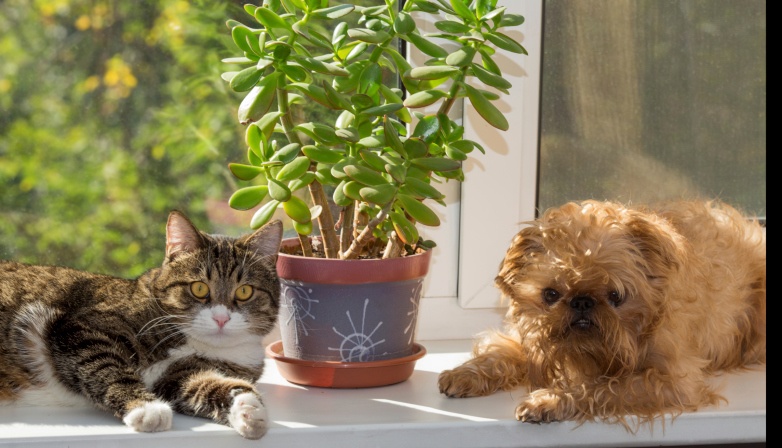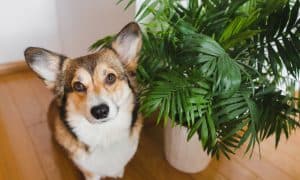“This post contains affiliate links, and I will be compensated if you make a purchase after clicking on my links.”

Houseplants generally serve a number of favorable functions. They not only give visual interest to our home, but also serve as air purifiers. They may even be edible and medicinal. However, it’s crucial for a responsible owner like you to be mindful of the kind of houseplants in your home and garden since some of them can be toxic for your dog.
What to Keep Out of Fido’s Reach
1. Aloe Vera. This popular succulent plant is a very useful herb for humans. As a matter of fact, it can serve as a soothing lotion for burns. While the gel found in aloe vera leaves is alright for your pooch, the outer leaves, however, contain saponins which can cause nausea, diarrhea, vomiting, and tremors.
2. Apple and Cherry Trees. Many parts of these two common trees are said to be poisonous to dogs. The leaves, stems, and seeds of apples have cyanide which can cause breathing difficulties, panting, dilated pupils, and shock. Their fruit, on the other hand, can be a great snack for your healthy pooch.
3. Asparagus ferns. This houseplant is often found in hanging baskets inside of homes. Asparagus ferns are toxic plants that contain sapogenins which can trigger allergic dermatitis. Once the plant grows berries, ingestion of them can result in diarrhea, abdominal pain, vomiting, and nausea.
4. Azalaeas and Rhododendrons. These pretty flowering shrubs contain grayantoxin which can affect a dog’s nerve and muscle function; thereby, causing depression, colic, dizziness, diarrhea, loss of appetite, excessive drooling, leg paralysis, weakness, and slowed heart function.
5. Christmas Cactus and Clematis Vines. Ingesting the flowers, leaves, or branches of Christmas cactus can bring about depression, bloody diarrhea, and vomiting. Clematis vines, on the other hand, contain protoanemonin which is an irritant that can set off diarrhea, vomiting, and excessive drool in dogs.
6. Common Privet Hedge. This plant’s needles and branches have terpenoid glycoside which is a toxin that can produce intestinal upset, racing heart, and loss of balance and coordination in your pooch.
7. Eucalyptus. Oil in eucalyptus can trigger depression, excessive drooling, diarrhea, vomiting, and lethargy.
8. Garlic. Another common but toxic houseplant is garlic. It’s a vegetable garden plant that contains N-propyl disulphide which is a poison that can bring about deterioration of red blood cells, blood in urine, panting, lethargy, and rapid heartbeat.
9. Hosta and Rhubarb. While Hosta contains saponins that can result in diarrhea, vomiting, and depression, Rhubarb leaves and its uncooked roots, on the other hand, have soluble calcium oxalate which can trigger tremors, kidney failure, and excessive drool in your pet.
10. Red Maple Trees. If your dog ingests its leaves, symptoms of red maple poisoning can include change in urine color, abdominal pain, darkened membrane in the eyes and mouth, lack of appetite, inflamed paw, and lethargy.
While these 10 plants top the list for being the most toxic for dogs, there are hundreds of other common plants that could potentially harm your pet. Some other poisonous house and garden plants and trees you might recognize include: Amaryllis and many other varieties of lilies, several varieties of Holly, other fruit trees, like peach, apricot, and plum, Norfolk Pine, Baby’s Breath, Birds of Paradise, Begonias, Carnation, Chrysanthemum, Corn Plant, several varieties of palms, Daffodils, Daisies, varieties of Ivy, Hyacinth, Gardenia, Geranium, Gladiola, citrus trees, like lemon, lime, and grapefruit, Morning Glory, Mums, Oleander, and many, many more.
For a printable list of plants known to be toxic to dogs, click here.
If you believe your dog has ingested any poisonous plants, the Animal Poison Control Center is available 24 hours a day, 365 days a year as a resource for any animal poison-related emergency. If you think that your pet may have ingested a potentially poisonous substance, call (888) 426-4435 for guidance, or visit your nearest veterinarian or animal hospital.














